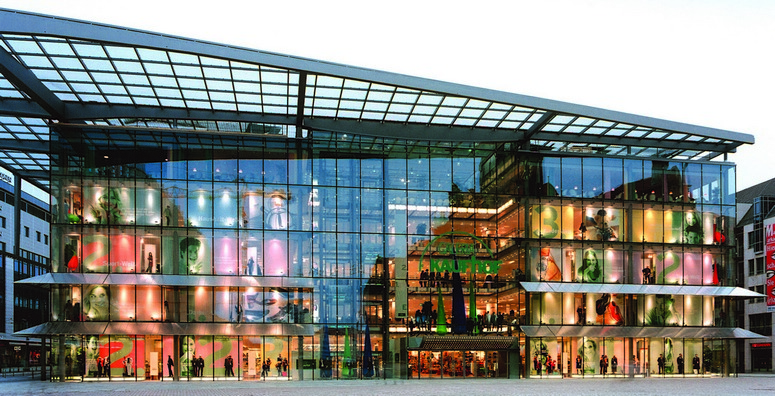By Christoph Meyer
Today, most German citizens are department store experts. The vast majority of them say the stores are the dinosaurs of the retail trade and are in danger of extinction.
It all used to be so different. For a hundred years, department stores were the most important innovators in retail and a particularly expansive type of operation. Beginning in the 1880s, Rudolf Karstadt & Co. opened stores in most German cities. Initially, most stores were small, but they quickly developed an appetite for more. They ate their way through neighborhoods, enveloped one next-door plot after another, and thus became the great colossi of our inner cities. Each new department store and enlargement of an existing one was received enthusiastically by local customers and each opening was celebrated with pomp in the presence of the proud mayor.
Even in the 1960s, when the next colossus of commerce, the shopping center, began to conquer Germany, the department stores were right at the forefront. They took over the stores at the ends of malls that were necessary for their proper functioning—at the time, most malls were built in a “bone” shape, with a mix of segments on smaller spaces anchored by two large stores at the ends. In the Alstertal shopping center, ECE’s flagship in Hamburg-Poppenbüttel, there were even two department stores, Kaufhof and Horten, at each of the mall’s endpoints up to the 1990s.
Suddenly lead story in the TV news
The general public never suspected that these giants would ever have problems. It wasn’t until 2008 and 2009, when Hertie and Karstadt (respectively) went into bankruptcy, that the topic of department stores became a lead story on the TV news and began to be discussed in German living rooms in addition to among a number of politicians. Although Karstadt has begun a reorganization that is still not finished, Hertie has closed its 73 locations permanently. From the once-thriving German department store landscape, many German citizens still remember names like Horten, Kaufhalle, and Kepa, but only Karstadt and Galeria Kaufhof remain.
Even now, as those two remaining German department store groups are investing heavily in their future, that future remains uncertain. The only certainty is that more department stores will close. This is confirmed by press reports like that on the leasing of a Galeria Kaufhof building in Berliner Allee in Dusseldorf to Edeka’s Zurheide, which plans to create a gastronomy temple on the site; or on the imminent closure of a Kaufhof at Ostbahnhof in Berlin’s thriving Friedrichshain district in 2017.
Department store closures are nothing to worry about in the affected cities, however. On the contrary, the example of Hertie shows that department store closures also always offer opportunities for urban development, for retailers with successful concepts, and last, but not least, for investors. That’s because most department stores are located at very busy locations with correspondingly high sales potential for many retail sectors.
Location doubles value
Moreover, it is an enormous advantage to have city planners on your side when you restructure a department store property in times like these, when it is difficult for project developers to get new retail space approved. The vast majority of stores are at sites in so-called “core” areas, at which pretty much any commercial use is allowed according to the German Land Use Ordinance. Unlike for many retail projects, the planning law in effect gives a green light for almost all alternative uses and political support comes on top of it, because local politicians don’t want to have vacant department stores in their hometowns because they generate bad press and voters don’t like them. The actual value of most department store properties is therefore double in the sense that their locations provide good footfall on the one hand and beneficial planning laws on the other!
The biggest challenge in the restructuring of department store real estate is in the existing building itself. The fact that department stores have several floors often prevents adequate use by other retail concepts. The simplest way forward is of course to find a user that can take over the department store, or most of it, more or less as-is. Retailers like TK Maxx and Primark that can handle operating on several floors are examples. Primark, for instance, is currently in talks on the location of the former Karstadt in Stuttgart’s Königstrasse.
In stores with only two sales floors, Kaufland is a potential partner. Kaufland even completely took over six of the 73 former Hertie locations. In order for the three-story Hertie property in Hamburg Langenhorn to work, the sales area in the basement was simply converted into a parking garage.

Usually too little daylight
More common than solutions with a single user is transforming a department store into a commercial building with several retail tenants in the basement, ground, and first floors. Even then, it is best to endeavor to gain retailers that will operate larger units with at least two stories. Companies such as C&A and H&M have proved reliable partners for such projects, as with the restructuring of the Hertie in Elmshorn, a suburb of Hamburg.
If there are more than three levels available, however, you have to come up with more innovative solutions. Since the structure of most department stores is very deep, large parts of the rental space are without sufficient daylight. The classic uses for the upper floors, namely offices and apartments, are therefore out of the question. You would have to construct atriums within the building, which would be an immense task. The existing spaces are therefore often given to tenants that require little or no natural light. Galeria Kaufhof at Berlin’s Ostbahnhof had some good ideas for dealing with unneeded dark spaces on the fifth and sixth floors: They were rented to a bowling alley and an electric go-kart track, where customers can drive without inhaling exhaust fumes. Usually, however, the spaces are rented to music clubs (discos), fitness centers, or self-storage businesses. At the latter, firms and individuals can rent storage boxes for files and the like, but the rental prices, and therefore returns, are low.
Turm Carree in Turmstraße in Berlin-Moabit is an example of the successful restructuring of a department store. Located within the city close to the government district, the neighborhood had long lain dormant. On its main street, Turmstraße, directly at the underground station, the Berlin-based project developer MIB AG transformed the department store building previously used by Hertie into a modern, six-story office building with 9,800 sq m of rental space, 5,600 of which for retail. The main tenant is C&A. The fashion retailer originally wanted to move into the adjacent Schultheiss Quarter, but was lured away because the construction of the center was constantly delayed. The C&A store takes up 700 sq m on the ground floor and 1,600 sq m upstairs, connected internally via an escalator. Other large retail tenants include Reno-Schuhe, with almost 500 sq m on the ground floor, and a dm drugstore with a two-story store that manages to get by without escalators. A pharmacy also takes up two floors and uses a starting area of nearly 100 sq m on the ground floor and has an additional 300 sq m on the first floor. There is also an Asian supermarket, which fits perfectly into its surroundings with 1,300 sq m in the basement.
On the second floor, MIB AG leased space to a gym for women that usually gets by with little daylight. The same floor also houses several treatment rooms that compensate for the lack of natural light. Finally, on the third and fourth floors, MIB AG developed the 2,500-sq-m apartment concept “Bike Living.” The building is equipped with a fairly large elevator, so residents can head directly to their apartments by bike. The access corridors are also significantly wider than usual and each apartment contains a theft-proof bicycle parking station. Both the wider corridors and the bicycle parking ensure that the building’s depth is optimally utilized.
Examples from smaller towns
Some might think department store restructurings can only be successfully implemented in major cities. There are actually numerous good examples from smaller towns as well, like Detmold, Husum, and several others. Many investors have realized that they like to buy department store properties, even conservative ones like the Catholic organization Aachener Grundvermögen. They are right. For as long as department store properties are leased to Karstadt or Galeria Kaufhof, they provide returns. Should that at some point no longer be the case, however, they usually have even more potential. There are no standard solutions, however, only individual ones based on each location and building. Which is the best in a particular case must be examined prior to purchasing. As early as at the notary’s office, investors should always have a development plan for the department store location in their pockets.
About the author

Christoph Meyer is Managing Partner of the Berlin consultancy CM Best Retail Properties GmbH. He previously worked for 17 years at BNP Paribas Real Estate, where he was responsible in management for retail services. From 2008 to 2011, the retail expert and his team crafted solutions for 30 former Hertie department stores. Since then, he has been advising investors on the purchase and restructuring of department stores. Meyer is a lecturer on department stores at the International Real Estate Business School (IREBS) and Chairman of the Urban Development Committee at the Berlin Chamber of Industry and Commerce.





